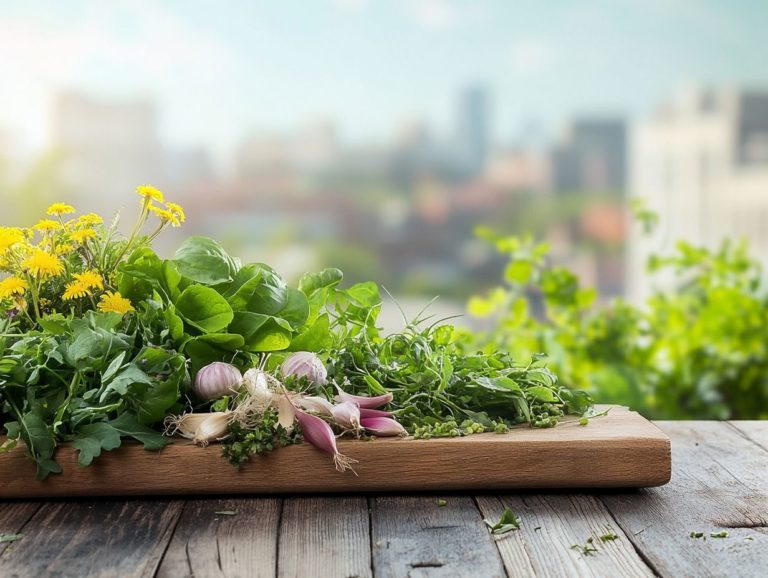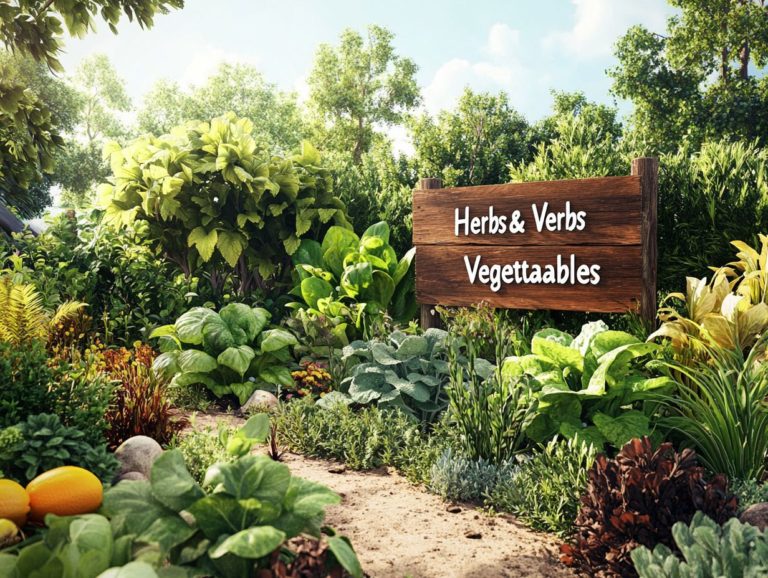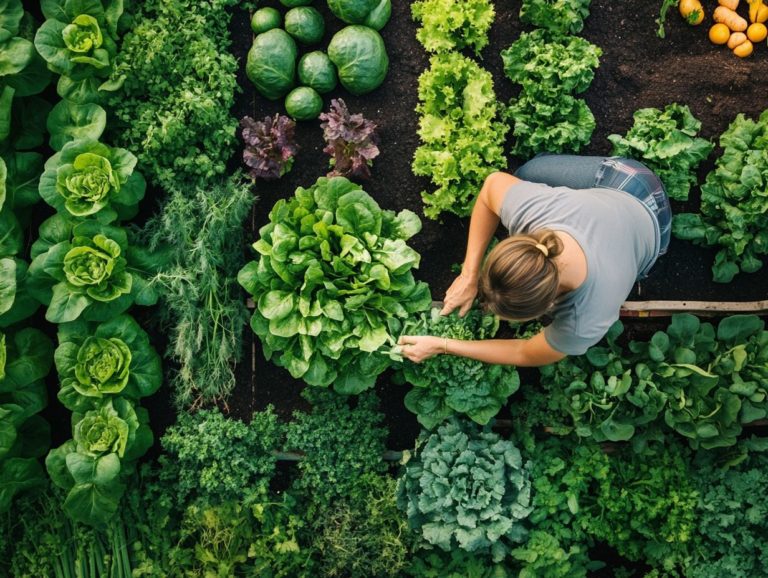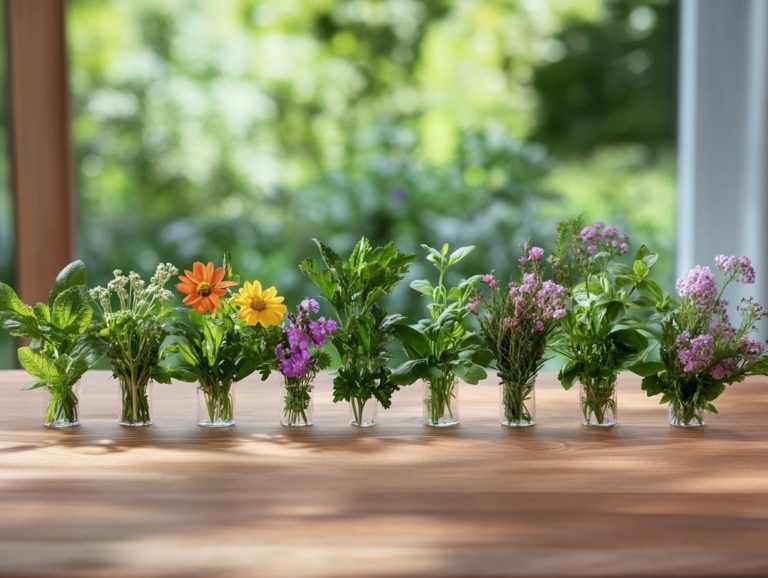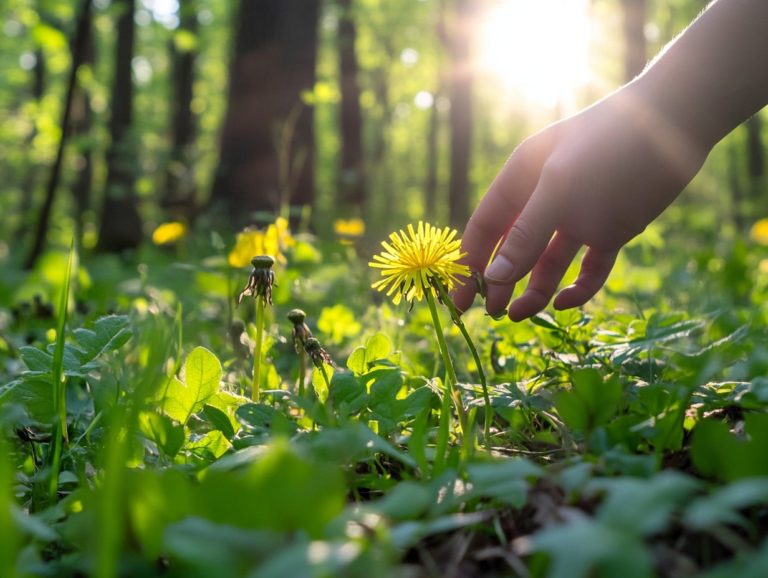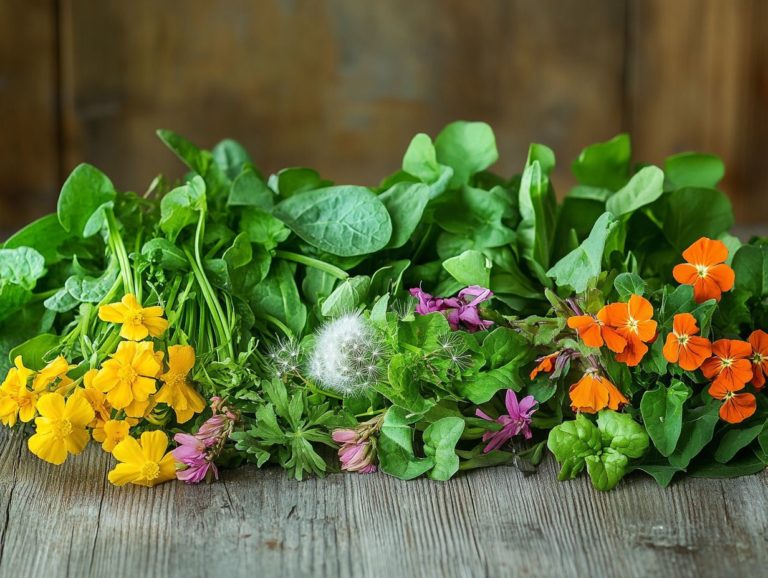Wild Edibles in Your Backyard: A Guide
Have you ever strolled through a park or your backyard, pondering which plants are not only visually stunning but also edible?
Wild edibles present a remarkable opportunity to explore flavors and nutrients right at your doorstep. This guide delves into the myriad benefits of incorporating these natural foods into your diet, highlighting their impressive nutritional profiles and sustainability.
You will uncover how to identify, harvest, and safely prepare a variety of wild edibles, complete with enticing recipes to try in your own kitchen. We ll also address potential risks to ensure your foraging adventures are both safe and rewarding.
Dive into the exciting world of wild edibles today!
Contents
- Key Takeaways:
- Benefits of Incorporating Wild Edibles into Your Diet
- Nutritional Value and Sustainability
- Identifying and Harvesting Wild Edibles
- Safe and Ethical Gathering Practices
- Preparing and Cooking Wild Edibles
- Discover the Wonders of Wild Edibles
- Common Types of Wild Edibles
- Possible Risks and Precautions
- Potential Poisonous Plants and Safety Measures
- Frequently Asked Questions
- What are wild edibles?
- Why should I forage for wild edibles in my backyard?
- Is it safe to eat wild edibles from my backyard?
- What are some common wild edibles that can be found in my backyard?
- How can I incorporate wild edibles into my meals?
- Are there any precautions I should take when foraging for wild edibles in my backyard?
Key Takeaways:
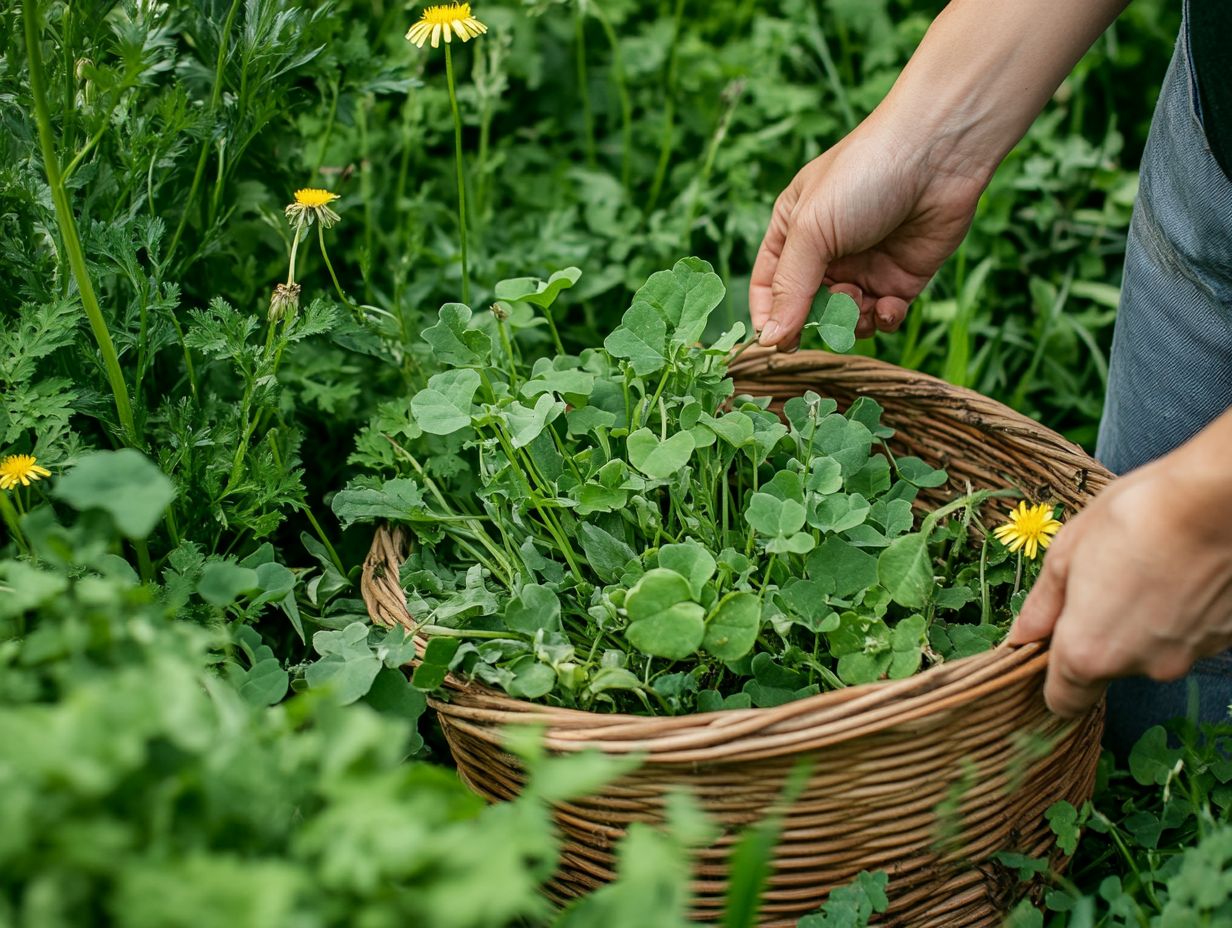
- Wild edibles boost nutrition and support the environment.
- Always check for safety before picking wild plants.
- Transform wild edibles into tasty meals like salads and stir-fries!
What are Wild Edibles?
Wild edibles offer a fascinating array of plants, from edible weeds to medicinal varieties. You can find them waiting to be discovered in your backyard and nearby natural habitats. As interest in sustainable living grows, making choices that protect the environment and conserve resources and natural nutrition, you’re likely to find yourself drawn to the art of backyard foraging. To get started, check out what to forage in winter, as foraging is a fun way to connect with nature.
Picture dandelion greens and wild garlic, alongside the invigorating self-heal herb and mouthwatering chickweed pesto. The world of wild edibles is brimming with flavors and health benefits just waiting for you to explore. By understanding what qualifies as wild edibles and their nutritional contributions, you can unlock a treasure trove of organic greens and unique culinary experiences.
Take dandelion leaves, for example; they re not just packed with vitamins A and C. Their slightly bitter flavor can elevate your salads or shine as a saut ed side dish. Then there s plantain, which you might spot in disturbed soils. It boasts impressive anti-inflammatory properties and can easily be transformed into soothing teas or a handy wound salve. Wild violets, with their delightful floral notes, add a charming touch to salads and desserts, offering both antioxidants and a distinctive taste.
By learning to identify these plants through resources like field guides or foraging courses, you can confidently integrate wild edibles into your daily meals, enriching your diet with vibrant and healthful offerings from nature.
Benefits of Incorporating Wild Edibles into Your Diet
Incorporating wild edibles into your diet opens the door to a wealth of health benefits. They elevate your meals into nutrient-rich experiences brimming with nature’s healing properties. These edible weeds and wild plants, from dandelions to chickweed, not only amplify the flavors of your dishes but also offer anti-inflammatory benefits and act as potent herbal remedies.
As more individuals embrace the art of backyard foraging, the awareness of how these resilient plants can enhance natural nutrition expands. This highlights their vital role in a balanced diet and overall well-being.
Nutritional Value and Sustainability
The nutritional value of wild edibles is often unmatched, offering a wealth of vitamins, minerals, and phytonutrients essential for a healthy diet, including nutritional gems.
For instance, when you forage for seasonal gems like nettles and dandelion greens, you elevate your culinary options while embracing a diet connected to local ecology. These wild plants boost your health and offer benefits like improved digestion, as they are packed with iron and vitamins A and C.
By prioritizing sustainable foraging practices, you help maintain the delicate balance of ecosystems, ensuring that future generations can also enjoy nature’s bounty of native species. Integrating more of these nutrient-dense wild foods into your diet allows you to experience improved well-being while supporting the biodiversity of your local environment.
Identifying and Harvesting Wild Edibles
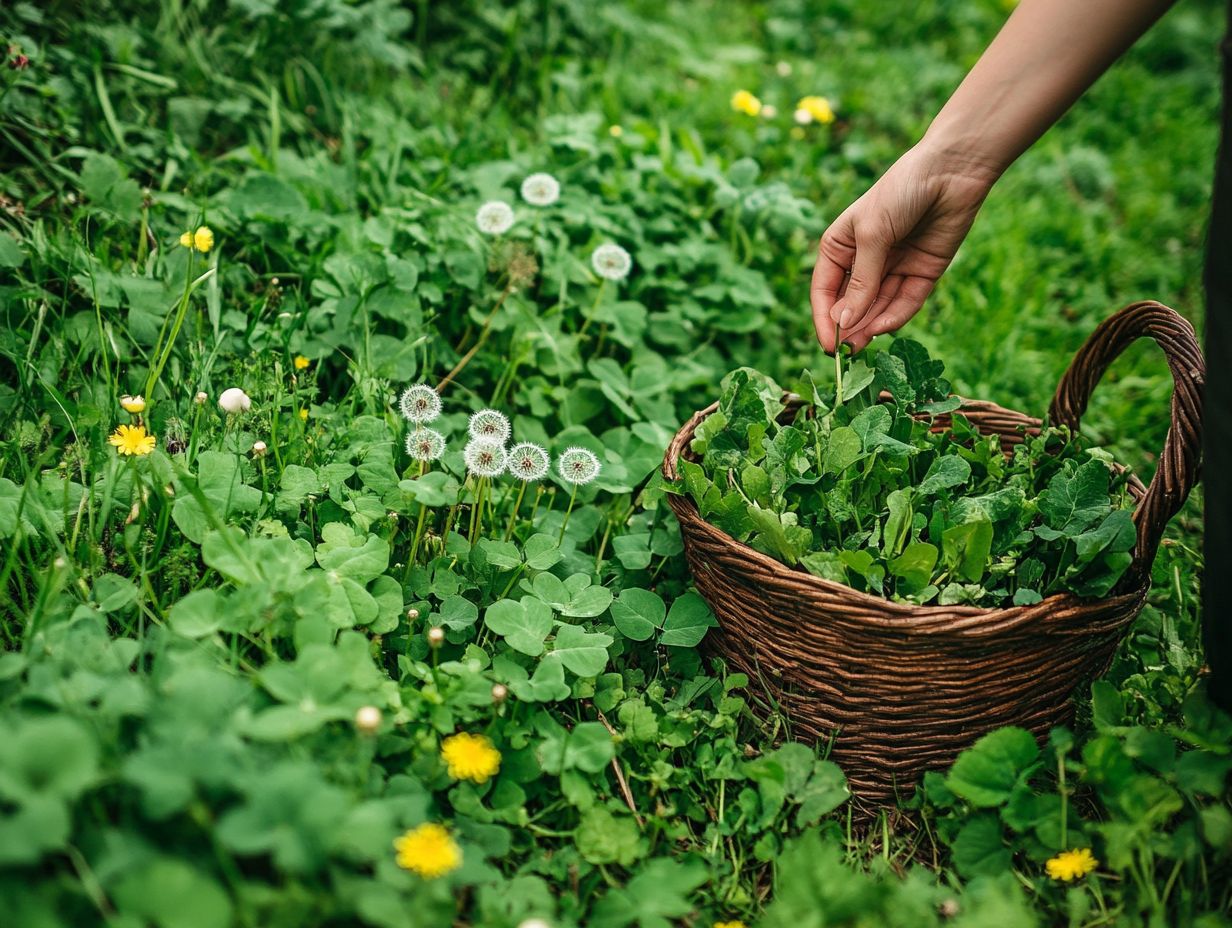
Identifying and harvesting wild edibles require careful observation and knowledge, as mastering proper recognition is essential for safely enjoying nature’s bounty. By enrolling in a foraging course or accessing free resources, you ll discover how to distinguish beneficial plants, like plantain, from their potentially harmful look-alikes.
Embracing ethical gathering practices allows you to sustainably harvest wild edibles such as wild berries and nutrient-rich greens. This not only promotes the regrowth of these valuable plants but also ensures fruitful foraging adventures featuring wild onions and wild garlic.
Safe and Ethical Gathering Practices
Safe and ethical gathering practices are essential for anyone interested in foraging wild edibles, ensuring both your well-being and the health of the environment. Learn responsible harvesting techniques to protect our ecosystems while enjoying the sustainable collection of medicinal weeds and delightful wild culinary ingredients.
Educating yourself on the principles of wildcrafting, the practice of gathering wild plants sustainably, allows you to enjoy your harvest while preserving nature’s bounty for future generations. Familiarizing yourself with local regulations can reveal vital information about protected species and areas where foraging may be restricted.
It’s important to only harvest what you can use, as this promotes sustainability and minimizes waste. This mindful approach protects wildlife and plant habitats from over-exploitation and encourages a balanced ecosystem, supporting herbal remedies and medicinal plants.
Embracing this practice means acknowledging the crucial role that diverse plant species play in maintaining healthy habitats, fostering a sense of stewardship and responsibility towards the natural world.
Preparing and Cooking Wild Edibles
Preparing and cooking wild edibles opens up new and exciting culinary possibilities, where you can experiment with distinctive flavors and enjoy health benefits by incorporating wild mushrooms and wild carrots into your dishes.
Imagine crafting a delightful salad with freshly foraged greens or whipping up a sumptuous chickweed pesto; the versatility of these wild plants can truly elevate any meal.
Incorporating wild mushrooms and other foraged ingredients into your cooking enhances your experience and introduces nutrient-dense elements that nourish both body and mind, including wild garlic for added flavor.
Discover the Wonders of Wild Edibles
Exploring wild edible recipes and cooking techniques can elevate your everyday meals into extraordinary culinary adventures. These techniques highlight the unique flavors and health benefits of foraged ingredients. Whether you’re crafting an herbal salve from dandelions or using wild garlic in savory dishes, these recipes offer endless opportunities for creative cooking.
By experimenting with various wild plants like purple dead nettle and wild strawberries, you can discover new favorites that enhance both flavor and nutrition. Don’t forget about the delightful wild fruit that nature provides!
Foraged foods bring exciting flavors and a healthy punch to your meals. For example, blending young nettles into a creamy soup creates a nutrient-rich dish that preserves the essential vitamins of the leaves when prepared with care. Saut wild mushrooms with fresh herbs for an aromatic side dish that beautifully complements any main course.
Sharing techniques like dehydration (removing moisture from food to preserve it) or quick pickling (a method to quickly preserve foods in vinegar) allows you to save the flavors of the season while exploring new combinations. Each recipe invites an adventurous spirit into your kitchen, turning the process of cooking with wild edibles into a delightful journey of discovery.
Common Types of Wild Edibles
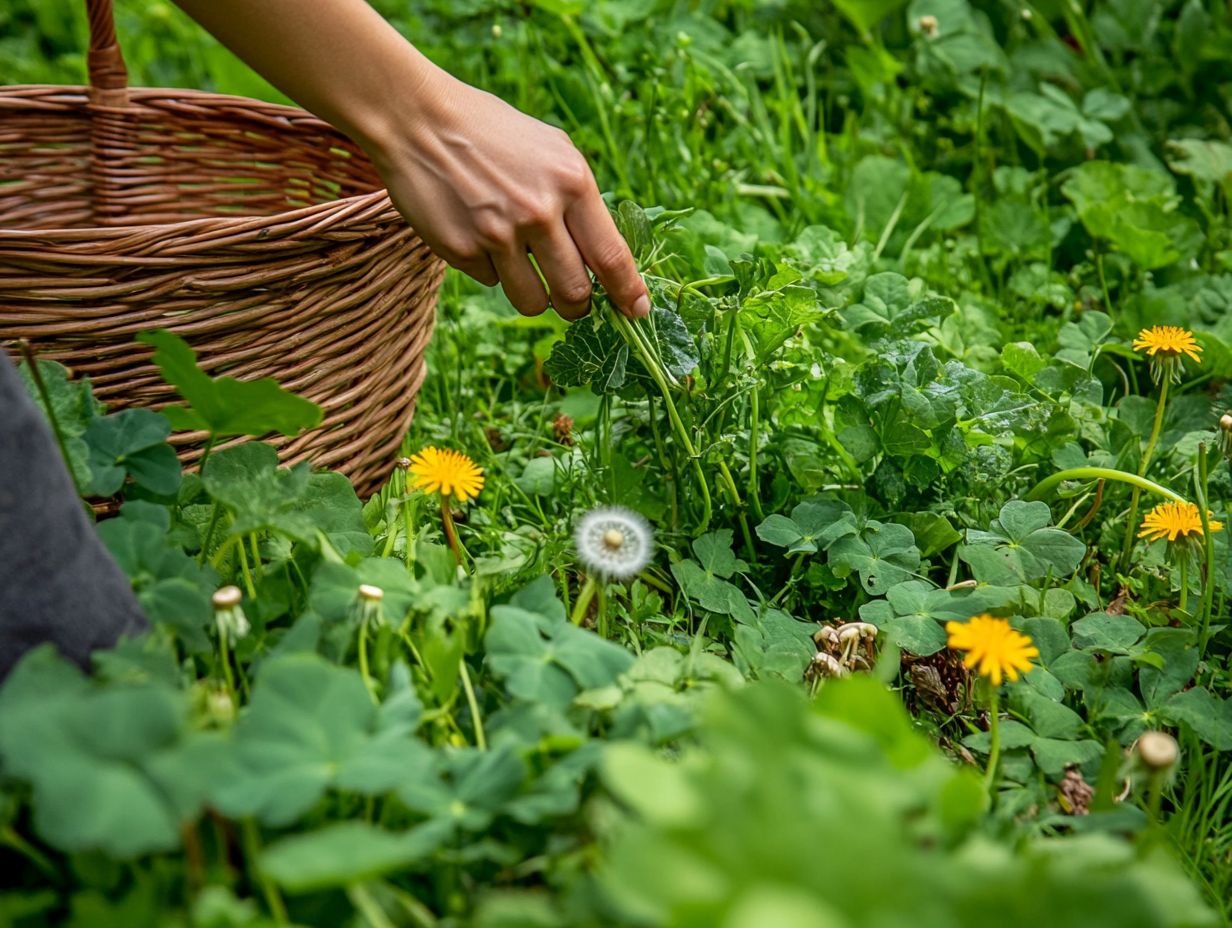
Common types of wild edibles encompass a diverse array of nutritious weeds and wild plants. Each one is brimming with unique flavors and health benefits, including wild carrots and wild grapes.
Imagine foraging for dandelion greens, chickweed, wild strawberries, and wild carrots. These treasures present delightful culinary possibilities for those eager to embrace nature’s bounty.
By understanding the characteristics and uses of these wild edibles, you can enhance your foraging experience and deepen your appreciation for the resilience and bounty that nature generously provides, including the healing properties of these plants.
Overview of Popular Varieties
When venturing into the world of wild edibles, it’s essential to grasp an overview of popular varieties for both safety and enjoyment. Familiar plants like dandelion, chickweed, and purple dead nettle are nutritious and easily recognizable during your foraging adventures.
The self-heal herb and wild garlic offer distinct flavors and health benefits. They are fantastic additions for anyone looking to enhance their culinary repertoire with nature’s bounty while exploring the plantain benefits.
Discovering these plants provides a unique gastronomic experience while deepening your connection to local ecosystems. Picture dandelion greens tossed in salads or steeped in teas. Chickweed’s mild flavor makes it an ideal companion for sandwiches, while purple dead nettle can transform a simple pesto with its anti-inflammatory properties. Brew self-heal into a calming herbal infusion for a soothing drink.
And don’t miss out on wild garlic! With its unmistakable aroma, it can elevate your dishes with a robust taste. By incorporating these wild edibles into your meals, you unleash your culinary creativity and cultivate a profound appreciation for the natural world around you.
Possible Risks and Precautions
Foraging for wild edibles can be incredibly rewarding, but know the risks! It’s vital to recognize potential risks and take necessary precautions to ensure your safety. Familiarizing yourself with potentially poisonous plants and implementing effective safety measures can significantly reduce the chances of adverse reactions, allowing you to fully enjoy the foraging adventure.
If you’re eager to delve into medicinal weeds and herbal remedies, understanding which plants are safe to consume is essential for a successful and secure foraging journey.
Potential Poisonous Plants and Safety Measures
Identifying potential poisonous plants is essential foraging, as some wild edibles can closely mimic harmful species. Familiarize yourself with common poisonous plants and understand the necessary safety measures to avoid them while foraging in the wild.
By arming yourself with knowledge about the characteristics of edible weeds versus those that could lead to adverse effects, you can confidently navigate the treasures nature has to offer. Among the most frequently misidentified plants are the toxic water hemlock and the edible sweet cicely, which can easily be confused. Knowing these differences is crucial to avoid dangerous mistakes!
To deepen your understanding, consider investing in reliable field guides that provide clear images and descriptions. Participating in local foraging classes can also enhance your identification skills, making safe harvesting practices second nature.
Before consuming any wild plant, conduct thorough checks and consult multiple sources to confirm its safety. This ensures that your outdoor culinary adventures are both healthy and enjoyable.
Frequently Asked Questions
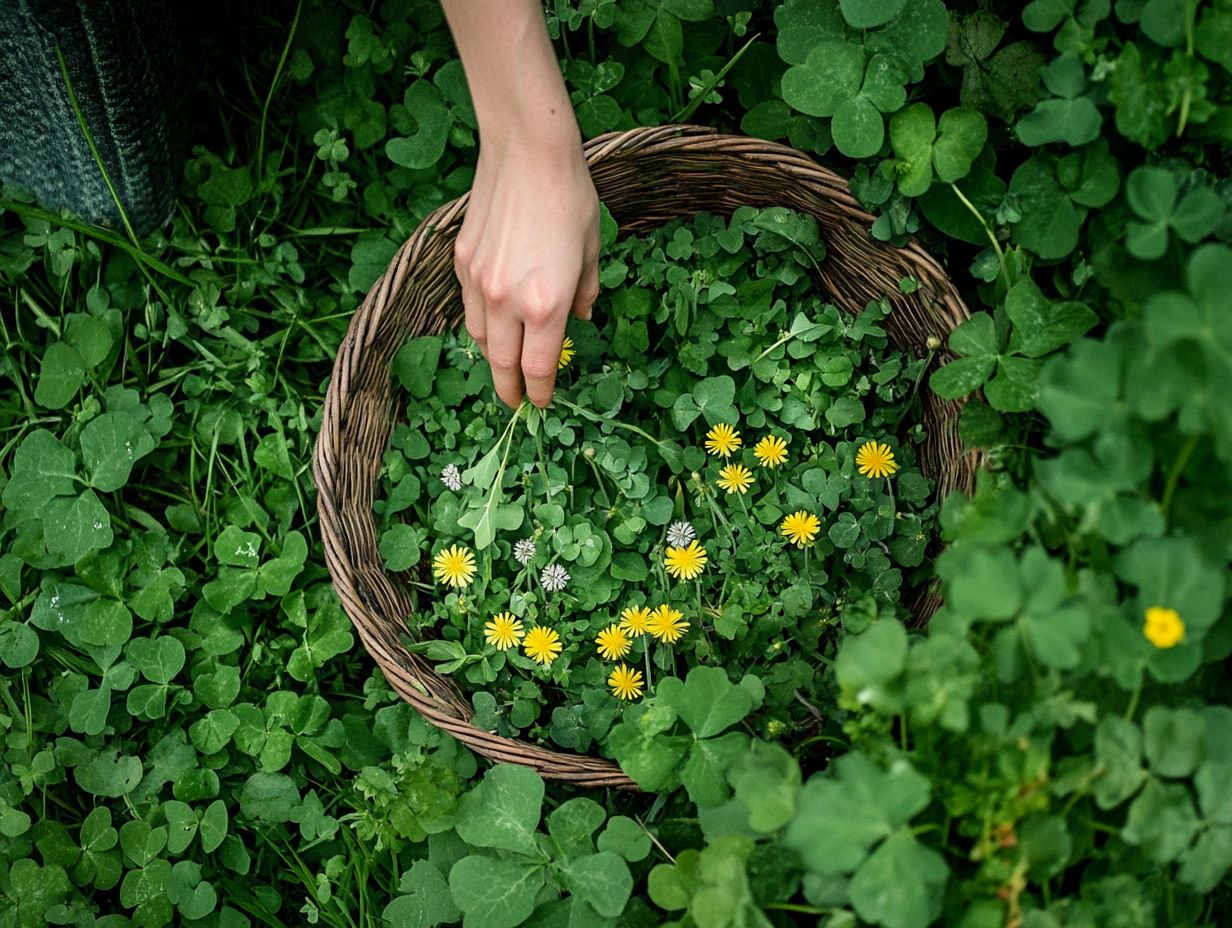
What are wild edibles?
Wild edibles refer to any type of plant or fungi that is safe and nutritious for human consumption. These can be found growing naturally in the wild, including in your own backyard.
Why should I forage for wild edibles in my backyard?
Foraging for wild edibles in your backyard is a great way to connect with nature, save money on groceries, and add nutritious and delicious ingredients to your meals. However, it’s important to follow safety guidelines, so consider these safety tips for wild edibles.
Is it safe to eat wild edibles from my backyard?
It is safe to eat wild edibles from your backyard as long as you properly identify them and ensure they are not contaminated by chemicals or pesticides. To learn more about responsible practices, always consult with a local expert or guidebook before consuming any wild plant or fungus. Understanding wild edibles and sustainable harvesting is crucial for future generations.
What are some common wild edibles that can be found in my backyard?
Common wild edibles that can be found in your backyard may include dandelion, clover, purslane, and wild berries such as blackberries and mulberries. To enhance your foraging skills, check out wild edibles: a guide to leaf shapes.
How can I incorporate wild edibles into my meals?
Wild edibles can be used in various ways in the kitchen, such as adding them to salads, soups, stir-fries, or using them as a garnish for dishes. They can also be dried or preserved for later use.
Are there any precautions I should take when foraging for wild edibles in my backyard?
Yes, always identify plants or fungi correctly for safety! It’s important to ensure that some plants can be toxic or cause allergic reactions. Avoid areas that may be contaminated by pollution or pesticides.

